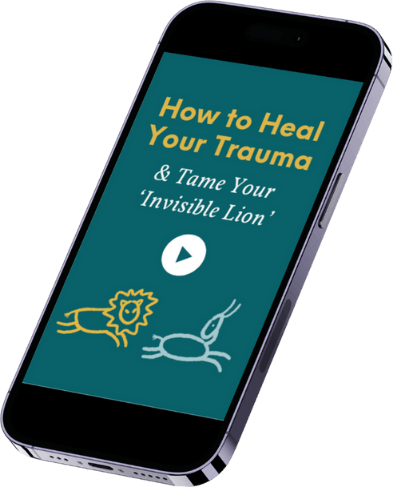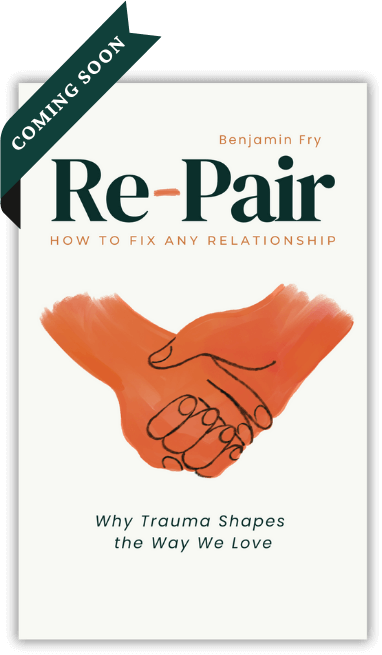Blog / Video #1
Consider the following story:
“Imagine you are walking along, minding your own business, when across the road you see a man running. He’s waving his arms wildly, screaming, turning this way and that, looking over his shoulder. He’s disheveled. He seems feral, wild. He’s frightening.
People get out of his way. They avoid him, crossing the road as they see him coming. You feel the urge to do the same because this guy makes you feel really uncomfortable. You tell yourself that he is crazy, that you are not like him.
You are just about to look the other way when you see something.
Around the corner bounds a lion. A fully grown, roaring lion. And it’s running after the man. Suddenly, you see the man differently. You understand that he is in danger. You want to help him. You are not alone. Other people see the danger. They also want to help.
No one thinks the man is crazy anymore. They are no longer afraid of him.
The man has not changed. He is still running wildly, terrified, blind with panic. Yet everything else has changed. His behaviour is exactly the same as before. His body is doing exactly what it was doing before. And somehow he has gone from crazy to normal, from being avoided to being helped.
What if you are the same? What if everything you think is wrong with you is actually normal, but just belongs to a different context? What if you are not crazy, or difficult, or sick, but just can’t see the lion?
The man’s behaviour is normal. His body is working perfectly. His reaction and choices are sane. But without being able to see the lion, he becomes a problem to solve.
You are reading this book because you are running away from a lion you can no longer see.
Nobody’s crazy. People want to help. They just can’t see the lion.”
Nobody is Crazy
In this story the same man is crazy, and then not crazy. By crazy, what we are really trying to say is that his behaviour doesn’t make sense. He seems panicked, or irrational, and then when we see the lion, he is normal. The difference between us labelling him as anxious or healthy is in fact context. This suggests that anxiety is not an illness, but the body expressing a confusion about what level of threat is in the environment.
Is it right therefore to talk about anxiety as a mental illness? Or even as poor mental health?
This might seem annoying if you have spent many years trying to get validation for your poor mental health, but the idea is profound. The story above tells us that anxiety, for example, isn’t something going wrong. This is not like having a virus, or cancer, or a broken bone. This is the body functioning perfectly. It is doing exactly what it is meant to do, but just in the wrong situation. It turns out that we could say the same for depression, OCD, ADHD, addiction, and personality disorders, among others.
Every moment of your life you are doing something very important to your survival; you are assessing threat. Over many millions of years every organism on this planet has evolved to survive by doing exactly that. So threat detection is at the core of our biological processes.
The Invisible Lion story above is really just a metaphor about that threat detection process gone wrong. Dr Stephen Porges calls this process “neuroception”. This is a made-up word which helps us to understand that it has nothing to do with thinking, or “perception”. Instead, it is about how the body and our senses are reading our environment. We don’t think it, we feel it. If you’ve ever felt anxious, you know that you can’t turn it off just by telling yourself there’s nothing to worry about. This is the difference between neuroception and perception.
Therefore, anxiety is faulty neuroception. And since neuroception is done in the body, why do we call this a mental health problem? It’s actually something which is going wrong lower down the brain stem in the anatomy.
Your body is not making up the lion, it is just reacting to it late. It can feel like something which happened thirty years ago is happening right now, even if you are just waiting at a bus stop.
The solution to this confusion is always the same; to get out of your head and into your body. This is why there is a new generation of body-based psychologies (such as Somatic Experiencing, Sensorimotor Psychotherapy and EMDR). And why there is a resurgence is traditional practices, like yoga, meditation, mindfulness, Tai Chi etc.
Get Into Your Body
All over the world, people restore their mental health and well-being by getting in touch with their bodies. In the west we tend to try to think our way out of the problem. This is like putting water in a car radiator when it has a flat tire. It’s a great solution for the wrong problem.
So, if you suffer from poor mental health, you have my sympathy (I’ve been there), but try to start understanding your problem differently. Your body is confused about the level of threat in your environment. Turn your attention inwards to your sensations, to get clearer in that place, rather than outward to fixing the world.
You can start with the simplest practice of all, a Body Scan. Below is a transcription of a Body Scan video that can found on YouTube and in the resources section of the The Invisible Lion.
“Come into a comfortable seated position on your yoga mat.
Sit tall. Take a deep breath in through your nose, and exhale fully with a sigh.
Let your hands rest on your lap, or on your thighs. And as you begin to breathe in and out through your nose, feel your stomach expand on the inhale and extract on the exhale.
As you breathe let your thoughts fizzle away, and bring your awareness to the space between your eyebrows. Relax that space.
Bring your attention to your jaw. So the mouth is closed but the teeth are apart. Relax your jaw.
We’ll begin the body scan from the top of the head.
As I say the parts of the body, just visualise relaxation, and if you feel any tension there, see if you can send your breath there like a laser, releasing any tension, or any stress or holding in that particular area.
Bring your attention to the top of your head. The forehead, the cheeks, the mouth, the back of the head, the top of the shoulders, the front of the chest, the upper back, the middle back, the lower back, the stomach, and the ribs.
Bring your awareness to your shoulders, the biceps, the triceps, the forearms, your hands.
Bring your attention to your hips, feel yourself firmly rooted into the mat.
Bring your attention to your thighs. The right thigh, The left thigh, The right knee, the left knee. The right shin, the right calf muscle. The left shin, left calf muscle. The right ankle, the left ankle. The right foot, the bottom of the foot, the top of the foot, the right toes. The left foot, the bottom of the foot, the top of the foot, the left toes.
Scan your body from your head to your toes, feeling yourself in total relaxation. Join your hands in prayer position and take a moment to acknowledge the sense of calm that you feel, and note that it has the power to carry you throughout the rest of your day, When you’re ready, seal in your practice with ‘Namaste.’”
You can download this post in a handy 2-page PDF to print and share with friends, family, clients or colleagues. Follow this link to download now.
You can buy a copy of The Invisible Lion now on kindle or paperback from your local Amazon store. Just click here to buy now.






